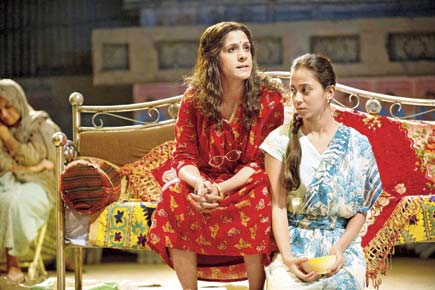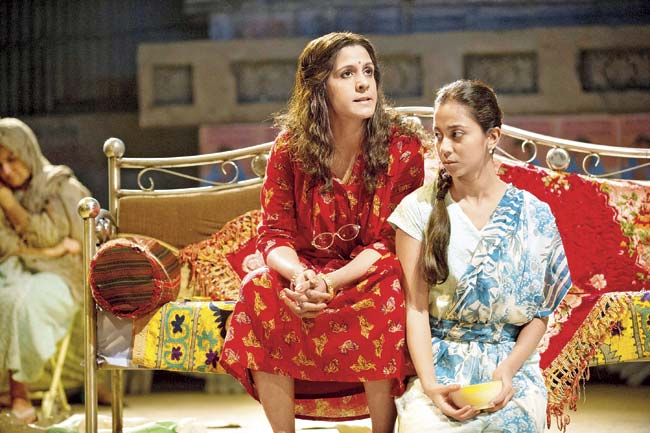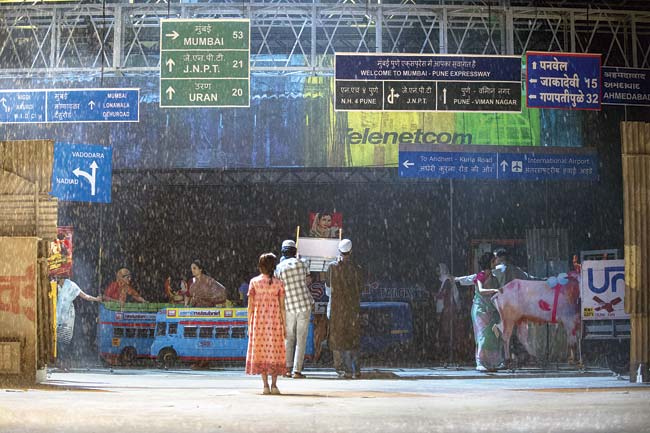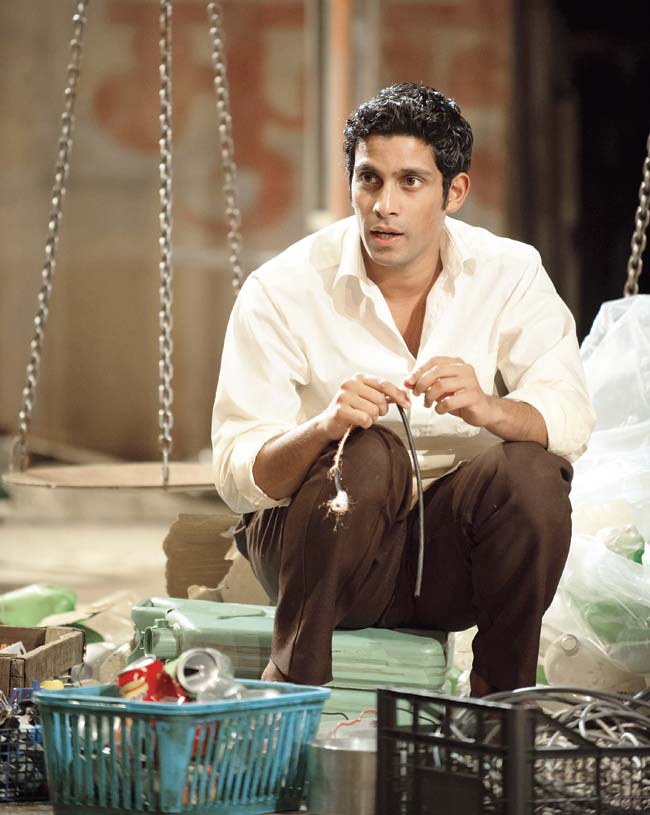The play Behind the Beautiful Forevers, set in a Mumbai slum, running to packed houses in London, shows that if men come from Mars and women from Venus, Indians and Westerners come from different solar systems altogether

We get any number of delegations from the CII and FICCI coming to London to promote India as an ideal country for investment, especially now that a strong government led by Narendra Modi is in place.

The curtain goes up and the play comes alive. The mock-up of the slum is very convincing
ADVERTISEMENT
Much of this positive image building is undone at a stroke, alas, with a play such as Behind the Beautiful Forevers which is playing to packed houses at the Royal National Theatre, which, alongside the Royal Shakespeare Company, is Britain’s principal venue for innovative, cutting-edge and experiment work.

The multiple choices in life are highlighted in the adaptation
Behind the Beautiful Forevers is grim but I have told myself I will reserve judgment until I have seen it again, and it won't be easy getting a ticket. It is set in a Mumbai slum called Annawadi, which is directly under the flight path of the giant aircraft descending into or taking off from the international airport. It is based on the prize winning book of the same name by Katherine Boo, a writer for the New Yorker.

The play brings Mumbai’s slums to a London stage
Her complex web of stories of everyday folk struggling to eke out a living by gathering and selling rubbish has been turned into a stage play by David Hare, one of Britain’s most eminent playwrights. It has been directed by Rufus Norris, the man due to take over shortly as artistic director of the National, a position once held by the legendary Sir Laurence Olivier.
In fact, the play is being staged in the Olivier, the largest of the theatres at the National. The mock up of the Mumbai slum is so convincing, that the residents of Annawadi could possibly do a swap without noticing the difference.
Differences
Forget men and women coming from Mars and Venus respectively: what this play tells us is that westerners and Indians come from different solar systems.
How else to explain the western obsession with slums, especially Mumbai slums? Back in 2002, Andrew Lloyd Webber produced the musical Bombay Dreams (from an idea by Farrukh Dhondy written up by Meera Syal, who happens to be the star of Behind the Beautiful Forevers).
I was one of those Lloyd Webber asked round to drinks for he wanted to consult Indian opinion widely before going ahead with his project. I encouraged him as did many others, notably Shekhar Kapur. I remember someone asking Lloyd Webber why his musical wasn’t called Mumbai Dreams, to which his answer was, “Because it doesn’t have any music.”
In Sachin Tendulkar’s autobiography, written by Boria Majumdar, the cricketer mentions going to see Bombay Dreams which he says he enjoyed. That is not my recollection, though. Even before the interval, Sachin, who was sitting in front of me, and other members of the Indian cricket team trooped out. “They are offended by the depiction of a Bombay slum,” was the word, though they may have left due to some other reasons.
Yet, if they were offended by Bombay Dreams which tells the tale of how “Anything is possible on the silver screen”, I wonder what they will make of Behind the Beautiful Forevers. At any rate, Bombay Dreams introduced A R Rahman to the western world, and he went on to take two of the eight Oscars which Slumdog Millionaire, again, set in a Mumbai slum won in 2009.
The film did less well in India, where it was condemned (wrongly in my opinion) as “poverty porn” by quite a few people in Bollywood, than in most other parts of the world.
Slum
One coincidence is that Tessa Ross, head of films at Channel 4 who turned Vikas Swarup’s novel Q&A into the film Slumdog Millionaire, is joining the National Theatre as its chief executive early next year.
Which brings me to the third project set in a Mumbai slum. I went to a matinee performance of the play, which was packed with an almost exclusively white, elderly, middle class audience. I took along with me a journalist friend from Mumbai, Rahul Singh, paying his first visit to London since the death of his father, Khushwant Singh.
On the way in, we met Meera Syal, who looked remarkably composed despite the rigours of press night a few hours previously. Rahul was very honest as we came out after seeing the play, “Very good stage design and very good acting but somehow it didn't work for me.”
By coincidence, Rahul and I had been part of a group that had seen Slumdog Millionaire at the Regal Cinema behind the Mumbai Taj. He had loved the film, while another person had attacked it bitterly. As we left the National, an Englishwoman asked for the way to the Olivier. She had come to see the play. Rahul volunteered he had just seen it.
“Did you like it?” “Ok,” replied Rahul, adding accusingly, “Amit liked it a lot more.”
Unsettling
Two days later, I went back to the National and bought both David Hare’s script and Katherine Boo’s highly regarded book, sub-titled ‘Life, Death and Hope in a Mumbai Slum’. Rahul, who has lived all his life in Mumbai, thought the book was “better”.
The experience of sitting through Behind the Beautiful Forevers was so unsettling that it drove me to take an extreme antidote watch something unchallenging, Bollywood and truly awful. Chennai Express fitted the bill and lifted the spirits.
It is quite obvious that westerners do not see India as we see ourselves. Certainly, we have a great ability to ignore the poverty around us. Could it be that we look but do not see and are resentful when foreigners are fascinated by our slums?
Professor Sunil Khilnani, director of the India Institute at King’s College London tried to put Indian poverty into some sort of context in a longish article in The Guardian. He was supportive of the play. A day or so later, The Guardian had to point out that he was married to Katherine Boo — an omission which earned him an honourable mention in the satirical magazine, Private Eye. Fame indeed.
Can I recommend the play to anyone coming in from Mumbai? I came across a pertinent reader’s letter from a Sue Stapely, “Having flown back to the UK from Mumbai airport just two days ago the play, which we saw last night resonated strongly.
We observed the shanty town all along the road to the airport and wondered how its occupants survived, having ourselves enjoyed 10 wonderful days in Rajasthan visiting palaces, forts and grand hotels. While the staging of this piece was certainly dramatically powerful and the cast exemplary, I longed for more political comment from Hare and more coherence to the story telling.
Not having read Ms Boo’s book, I can only assume she covered a series of vignettes and anecdotes and had hoped that Hare might draw them all together more persuasively. Nonetheless, it was a strangely moving evening with a wonderful, predominantly Indian cast.”
Another reader, Caroline Byrne, expressed anger at the rave reviews from a majority of British theatre critics: “This turgid melodrama goes on and on for three hours. If you’ve seen Slumdog Millionaire or read White Tiger then you will have a deeper insight into the great hardship many Indians are exposed to than the trite interpretations from Boo’s book.
I am shocked by the four-star reviews the media have given and sense that reviewers are brown-nosing the new incoming director of the NT. Kudos to the actors for keeping their energy levels up despite this woeful script and hammy directing.”
Watch
However, just as an intellectual exercise, people from Mumbai should come and see the play if they possibly can and try to understand the perspective of British critics.
This is Time Out: “Behind the Beautiful Forevers is a window onto the lives of India’s poorest, most notably the hardworking Husain family, who make their meagre living sifting through Mumbai’s prodigious accumulation of rubbish.
With much gallows humour we’re brought into their messy world of small victories and crushing setbacks, the biggest of which comes when the damaged Fatima (Thusitha Jayasundera) immolates herself in order to frame the Husains. It almost destroys the hardworking family, as they are forced to bribe their way through India's mind-bogglingly corrupt legal system.”
“It is a brilliant, horrible and heartbreaking story, painfully small in its scale, but told with epic sweep and flourish by Norris,” adds Time Out. “There’s a particularly fine performance from Meera Syal as Husain matriarch Zehrunisa, a strong woman slowly ground down as she sells everything she owns to fund endless palm greasings.”
According to The Daily Telegraph, “The main achievement here is to cut a swathe through Boo’s sometimes restrictive-feeling prose and let her ‘characters; live and breathe, often using an amiable mode of direct address. The result is to further refine the original’s meticulously sifted material so that a clear pattern emerges of individuals struggling to keep body and soul together in a society that is indifferent to their fates and conspires, through bribery, corruption and inefficiency, to push their fortunes further down into the stinking pile.”
It goes on: “At the heart of both book and play is a minor spat that spins out of control. Diligent teenage ‘sorter’ Abdul Husain (Shane Zaza), his shack-proud mum (Meera Syal’s wry and dry Zehrunisa) and ailing father Karam (Vincent Ebrahim) embark on home-improvements that enrage their envious, one-legged neighbour Fatima (Thusitha Jayasundera). The latter sets fire to herself and then blames it all on them, ensuring the family swiftly face a Kafkaesque nightmare of injustice and incarceration.
While consistently enjoyable, the show resists the temptation to make the spectacle of poor people in desperate competition look exotic; the design is knowingly economical and the most eye-catching moment comes when a torrent of empty water-bottles cascades down.” What’s on Stage applauds “A wise and witty evening that allows us to wallow in our own good fortune while enjoying the desperate plight of others, a classic and complicated privilege.”
The Guardian believes that “David Hare’s adaptation of Katherine Boo’s acclaimed study of a Mumbai slum breaks new ground for the National. “It is a leap for the National.” There are bits of black humour that might force an ironic smile from someone coming from Mumbai.
For example, one of the characters rages at the anti-litter campaign. If people are going to stop throwing rubbish into the streets, what’s he going to collect? It’s all very well telling people to be socially responsible but that is bad for business.
Behind the Beautiful Forevers is booking at the National Theatre, London until April 13, 2015.
 Subscribe today by clicking the link and stay updated with the latest news!" Click here!
Subscribe today by clicking the link and stay updated with the latest news!" Click here!







